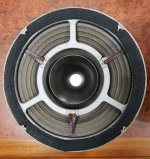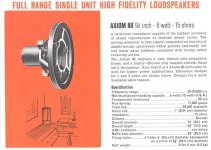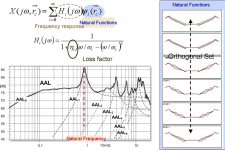As the title implies it's something to do with the past - at some point the industry decided suddenly that corrugated paper surrounds are no longer "good"... but why? I am asking this in the context of full range speakers, especially hi fi ones, perhaps I can understand why a subwoofer would have a surround made of rubber or foam but when it comes to fullrangers I suspect things are different. One observation I would like to point out is that on the used market if a driver has two versions one with paper surround the other what ever it's always the corrugated paper that is more sought after. So is the corrugated surround better? So people are looking for them but manufacturers refuse to make them?
How many hi fi models stil in production have corrugated surrounds? I know of Supravox (impregnated I think), other than that...? When was the last Fostex made with paper surround?
Another thing that should be mentioned is that paper surrounds are not exactly what they seem - I have measured a few and they are always thinner than the cone (half thin many times) so it's not a simple continuation of the cone but they don't seem to be glued either. In fact they are so thin many times you can see from behind how transparent they are in the right light.
And last but not least - can you buy a corrugated paper surround? to use on you existing speaker obviously.
How many hi fi models stil in production have corrugated surrounds? I know of Supravox (impregnated I think), other than that...? When was the last Fostex made with paper surround?
Another thing that should be mentioned is that paper surrounds are not exactly what they seem - I have measured a few and they are always thinner than the cone (half thin many times) so it's not a simple continuation of the cone but they don't seem to be glued either. In fact they are so thin many times you can see from behind how transparent they are in the right light.
And last but not least - can you buy a corrugated paper surround? to use on you existing speaker obviously.
As power increases, so goes driver compliance to use it. 😉 For HIFI/HT apps, much prefer enough efficiency to not need high Xmax, including subs. My subs only have ~ 75 W peak power/4 mm Xmax and can/have damaged the house, but it took [4] of them in a total of ~40 ft^3 corner loaded to do it.
GM
GM
There are actually some drivers that don't have a surround as such, but just flexes the whole cone.
Can't remember any names now, but you'd think it would imply a pretty heavily damped cone.
But it could have the advantage of having the coil in an iron grip, WRT to lateral twists and movement.
Essentially a double spider.
This would mean much tighter tolerances for the magnet gab possible and better efficiency.
Theoretically.
Can't remember any names now, but you'd think it would imply a pretty heavily damped cone.
But it could have the advantage of having the coil in an iron grip, WRT to lateral twists and movement.
Essentially a double spider.
This would mean much tighter tolerances for the magnet gab possible and better efficiency.
Theoretically.
Last edited:
Butyl or foam surrounds permit larger cone excursions and better damp reflections from the periphery of the cone.
The best surround is probably no surround at all, as was the case with the Goodmans Axiom 80 free-edge speaker.
The best surround is probably no surround at all, as was the case with the Goodmans Axiom 80 free-edge speaker.
Attachments
Butyl or foam surrounds permit larger cone excursions and better damp reflections from the periphery of the cone.
The best surround is probably no surround at all, as was the case with the Goodmans Axiom 80 free-edge speaker.
How exactly did that work? Was there simply a small gab? Or was there some kind of very light whispery material in-between, to avoid acoustic short-circuit?
It must have been a problem with reflections from the edge of the cone in the Axiom 80 (lateral wobbling squash and stretch, with the springs as pivots). How was that handled?
There was a gap all the way round the periphery of the cone - not wide, so not very visible in the photograph. The dual cantlilever system allowed large linear excursions while preventing lateral movement. The fundamental resonant frequency was a very low 20Hz.
Last edited:
There was a gap all the way round the periphery of the cone - not wide, so not very visible in the photograph. The dual cantlilever system allowed large linear excursions while preventing lateral movement. The open baffle resonant frequency was a very low 25Hz.
But the gab must have worked like a port. Both the actual movement of the cone and the air exciting the box must have made the three loose edges flap in the breeze (up and down/inwards and outwards. That's what I meant by lateral).
Or, that can't have been the case..?
Last edited:
The narrow gap did not act like a tuned port, but acted to reduce enclosure resonances.
The enclosure had to be very large, a 127 litre sealed box pushing the resonance up to only 40Hz.
The recommended loading was to use a Goodman's Acoustic Resistance Unit (ARU) which provided aperiodic loading in a smaller enclosure of 'only' 97 litres.
I'm quoting from the literature of the time (mid sixties) - I don't have any practical experience with this driver.
The enclosure had to be very large, a 127 litre sealed box pushing the resonance up to only 40Hz.
The recommended loading was to use a Goodman's Acoustic Resistance Unit (ARU) which provided aperiodic loading in a smaller enclosure of 'only' 97 litres.
I'm quoting from the literature of the time (mid sixties) - I don't have any practical experience with this driver.
When you think about it, the miniscule area of the narrow air gap around the circumference of the cone compared to the huge volume of the enclosure meant that it constituted only a small air leak. It couldn't act as a tuned port, that would require an opening of a much larger area.
No, not a tuned port. But perhaps a resistive port. But AFAIK the damping was almost entirely controlled by the magnet and the air in the cab so Qts must have been quite high.
Speakers with a port around the driver have actually been made. So it’s not a completely one-off, alien concept.
It must have affected bass in some way though?
Speakers with a port around the driver have actually been made. So it’s not a completely one-off, alien concept.
It must have affected bass in some way though?
Last edited:
This argument that paper surround excludes large excursion is not valid, low fs / large Vas drivers have been made with corrugated paper surrounds, it's just not the best solution for long "walks".
' Accordian ' surrounds limit excursion ,
but in a soft way . More like compression
than clipping .
but in a soft way . More like compression
than clipping .
I knew about that, I made some searches on the forum before starting a new thread; it's a subwoofer question, as I pointed out in the first post I am asking the question in the context of fullrange speakers, I am particularly interested in the dry version of the paper surround.
As Planet10 pointed back in 2003 - " accordian, or inverted half-roll (cloth/impregnated cloth my preference for these) being better if you want an extended range driver." - there may be preferences when it comes to what you make the surround of when you have a widerange unit. Paper was not mentioned...
A bit of update: managed to locate a fullrage speaker (not Supravox) with paper surround - Audax 13LB25AL 5" Full Range Paper Cone with Phase Plug - I think... but it's impregnated... and also from France.
As Planet10 pointed back in 2003 - " accordian, or inverted half-roll (cloth/impregnated cloth my preference for these) being better if you want an extended range driver." - there may be preferences when it comes to what you make the surround of when you have a widerange unit. Paper was not mentioned...
A bit of update: managed to locate a fullrage speaker (not Supravox) with paper surround - Audax 13LB25AL 5" Full Range Paper Cone with Phase Plug - I think... but it's impregnated... and also from France.
Accordion cloth surround on these, not paper though. Thought I'd post them anyhow in case you never saw them before etc. Its a company of a member here at DIY. I have no affiliation and have not heard them myself, but many do like them and they are reported to sound quite good.
Wild Burro Audio Labs - Fullrange Speakers - The Betsy & Betsy-K Drivers
Wild Burro Audio Labs - Fullrange Speakers - The Betsy & Betsy-K Drivers
It's interesting to see that the decription says "The one piece cone and surround has a lively sound with high sensitivity."A bit of update: managed to locate a fullrage speaker (not Supravox) with paper surround - Audax 13LB25AL 5" Full Range Paper Cone with Phase Plug - I think... but it's impregnated... and also from France.
I think the key words are 'lively sound'. A full range driver needs a bit of liveliness to make for a balanced frequency response.
The corrugated surround provides this liveliness by reflecting energy back into the cone instead of absorbing it in the way that a foam surround would.
Wait a second - if you get energy reflected back in the cone - isn't that a different way to say "resonance"? Are you suggesting a "hard" surround - but I did said these things are very light, almost transparent - is causing resonances? I don't know of any association between paper surrounds and resonances in the cone.
Wait a second - if you get energy reflected back in the cone - isn't that a different way to say "resonance"? Are you suggesting a "hard" surround - but I did said these things are very light, almost transparent - is causing resonances? I don't know of any association between paper surrounds and resonances in the cone.
Energy pulses (sound here) loose energy when it crosses from material of one density to another, but if the transition is too abrupt reflection will occur.
Notice how most paper surround drivers have relatively large cones, and it's only when you enter el cheapo territory that paper surrounds persist.
It's a delicate balance between control/stiffness on one hand and damping plus large xmax. abilities.
BTW is there any threads, of just general advice on how and if to treat old paper surrounds?
Some of these are getting quite old and they can begin to look fuzzy, which is breakdown of the paper.
Last edited:
Ok, energy is lost when the wave comes across a different material, but a dry surround made from paper well it's still paper (I consider impregnated paper surround not exactly paper due to added glue/gunk) so it keeps conducting the wave until the basket I guess. The nonpaper materials will more likely reflect some energy back if it's the density we worry about.
I' still waiting for someone to answer the questions in my first post, to my surprise there doesn't seem to be an immediately available answer to this, there must be an article somewhere or something from a book...
In the 60s hi fi fullrange drivers (and non hi fi) had corrugated paper surrounds... they were not invented to save money... and then dropped to spend more money.
I' still waiting for someone to answer the questions in my first post, to my surprise there doesn't seem to be an immediately available answer to this, there must be an article somewhere or something from a book...
In the 60s hi fi fullrange drivers (and non hi fi) had corrugated paper surrounds... they were not invented to save money... and then dropped to spend more money.
- Home
- Loudspeakers
- Full Range
- What was wrong with corugated paper surrounds?


